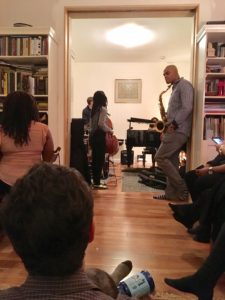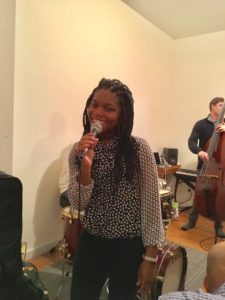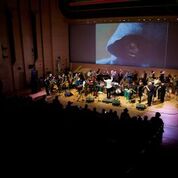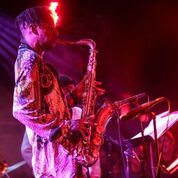The early January concurrence of the Jazz Connect conference, the annual convention of APAP (Association of Performing Arts Presenters), Global Fest and Winter JazzFest makes a good case for Manhattan being the capital of jazz-and-beyond.
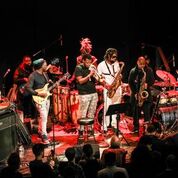
Shabaka and the Ancestors, London-South African band breaking out via Winter JazzFest at (le) Poisson Rouge; photo by Jati Lindsay
It’s inarguably true that creative sound-organizing with improvisation and rhythm is world-wide, and our native version — jazz and its derivatives – thrives throughout in the US, even in places it’s overlooked. And the record biz centralized in NYC, which fed this music’s market segment from the ’20s into the ’00s, is a blip of its past. But still, New York City . . .
The annual Jazz Connect conference ran Jan. 5 and 6, with some 1000 musicians, their managers, agents, labels, publicists, presenters, broadcasters and critics filling meeting rooms and even the chapel of St. Peter’s Church. Produced by the Jazz Forward Coalition (Peter Gordon of Carmel CA’s Thirsty-Ear Records, director) in partnership with JazzTimes (principally via Lee Mergner, publisher of the Braintree MA-based magazine and website) with special assistance from Don Lucoff of DLMedia (of suburban Philadelphia and the PDX Jazz Festival in Portland OR), Jazz Connect is the sole US get-together for jazz professionals who aren’t educators (they met the same weekend, this year in New Orleans, via the Jazz Education Network (JEN)).
I must have schmoozed with half of those at Jazz Connect, including friends and associates from Albuquerque (Tom Guralnick of the Outpost), Austin (pianist Peggy Stern, splitting her time in Kingston NY), the Bay Area (promotions and public relations specialist Marshall Lamm), Baltimore (writer Geoff Himes, JJA board member Don Palmer), Boston (Berklee student and JazzBoston newsletter editor Grace-Mary Burega), Boulder (Peter Poses, dj at KRFC), Columbia MO (Peter’s brother Jon Poses, of the We Always Swing jazz series),  Honolulu (Stephanie Castillo, filmmaker, director of Night Bird Song about the late Thomas Chapin), Los Angeles (Zev Feldman of Resonance Records), New Haven (musician and writer Allen Lowe), Richmond VA (broadcaster Josh Jackson), Rochester NY (Derrick Lucas, Jazz90.1), Paris (journalist and radio show host Alex Dutilh), Pittsburgh (journalist Mike Shanley), Portland OR (Matt Fleeger of KMHD), Seattle (Earshot’s John Gilbreath), Tucson (Yvonne Ervin; the Charles Mingus Festival and Memorial Park in Nogales, AZ is among her many works), Washington DC (Rusty Hassan of WPFW,  Willard “Open Sky Jazz” Jenkins, NEA jazz specialist Katja von Schuttenbach), Wilmington (writer Eugene Holley), Ypsilanti (WEMU’s Linda Yohn) —
— and of course many New Yorkers (journalist/educator David Adler, producer Todd Barkan, singer E.J. Decker, Jim “JazzPromo Works” Eigo, Barney Fields of HighNote/Savant Records, Albany/Nippertown jazz journo J Hunter, baritone sax star Howard Johnson, Jeff Levenson of Half Note Records, Village Voice and JazzTimes writer Aidan Levy, Jason Olaine of Jazz at Lincoln Center, pianist Roberta Picket (hanging out with saxophonist Virginia Mayhew), Mark Ruffin of Sirius/XM Radio, singer Kendra Shank, trumpeter-producer David Weiss, pianist-educator Eli Yamin, . . way too many to name) and fellow Chicagoans (saxophonist/AACM chair Ernest Dawkins, Hot House presenter Marguerite Horberg, writer/radio producer Neil Tesser) . . .
Many attendees, after hours of concentrated schmoozing, went directly to play or hear music, at one of the couple dozen venues detailed in the admirably comprehensive performance calendar of The New York City Jazz Record.
On the Thursday night I went with fellow Jazz Journalists Association members Angelika Beener and Ted Panken to hear L.A.-based pianist-composer-arranger John Beasley‘s star-studded Monk’estra at Dizzy’s Club in Jazz at Lincoln Center — beautifully detailed, original expositions of centennial celebrant Thelonious Monk‘s indestructible melodies (chatted with heir/drummer T.S. Monk there, as well as alto saxist Ted Nash — hear his Presidential Suite (Eight Variations on Freedom) and Jazzweek publisher Ed Trefzger)– then cabbed to the Harlem apartment of Azerbijian-born pianist-composer Amina Figarova and her husband flutist Bart Platteau, originally from Belgium for a party/jam session that included tenor saxist Wayne Escoffery, pianist Bertha Hope, bassist Ark Ovrutski, guitarist Roni Ben-Hur and 15-year-old singer Alexis Morrast giving lustrous voice to “My Funny Valentine.” Talked at length to Jim Wadsworth, presenter at Cleveland’s Nighttown, and photographer Gulnara Khamatova, one of the photographers for Winter JazzFest.
Friday Jan 6 was the first night of the WJF marathon, performances from dozens of new and emerging artists/ensembles from 6 pm to 2 pm simultaneously in 13 downtown venues. The clubs and concert halls are no longer grouped all on or near Greenwich Village’s main drag Bleecker Street — they’re now dispersed as far east at NuBlu on Ave. C, as far south as Bowery Ballroom at the edge of Chinatown, and west to S.O.B.’s on 7th Avenue South. Getting everywhere might be possible by bike, scooter or Segway but I ping-ponged only from 13th Street, where buildings of the New School offered variously sized stages, to (le) Poisson Rouge and Subculture on Bleecker, 10 blocks down.
My aim was to hear music not likely to be in Chicago soon, and I started with trombonist/composer/conductor Craig Harris‘ Breathe, which collected some 35 players to embody the JazzFest’s stated mission to “explicitly support social and racial justice by presenting socially engaged artist who have urgent and beautiful musical messages to share.”
Harris did this in a suite-like structure by featuring soloists – first up, Zusaan Kali Fasteau on ney — and spontaneously conjured backdrops, sometimes drawing from his established compositions (the finale has been recorded as “Lovejoy”). Individualistic expression was implicit in this plan, a diversity of personal statements that did not detract from overall unity of purpose. Closeup portraits projected behind the ensemble emphasized the humanness of those imperiled by racial discrimination — which is everyone.
On the advice of publicist Matt Merewitz, I hurried to Subculture for trombonist Jacob Garchik’s Ye Olde, with guitarists Mary Halvorson, Ava Mendoza and Jonathan Goldberger, plus drummer Vinnie Sperrazza. Garchik has earned his reputation as a skilled and witty composer-arranger. In this very loud setting, he outlined minimalisticly short riffs familiar from rock/r&b/pop classics, freeing the guitars to rampage wall-of-sound style. Mendoza is a find, and Ye Olde, which seeems highly tourable, may appeal to audiences that aren’t used to or interested in “jazz” per se. Maybe even for some who are. I stayed for a tune by singer Somi, accompanied by a quartet fronted by guitarist Liberty Ellman — also not for me.
Back in New School land, I caught trumpeter Paul Smoker with pianist Uri Caine, bassist Mark Helias and drummer Clarence Penn reeling a far abstraction back into its basis in the standard “All the Things You Are,” and then a highlight: Chicago drummer Mike Reed’s Flesh and Bone septet, with wild spokenwordsman Marvin Tate, alto saxophonist Greg Ward, bass clarinetist Jason Stein, cornetist Ben Lamar Gay, tenor saxist Tim Haldeman and bassist Jason Roebke showing how high energy blowing can be framed by riffs and rhythms for fun in balance with frenzy. Hot stuff — look for Flesh and Bone’s album in March-April. Nightcap was Arturo O’Farrill’s quintet with saxophonist Roy Nathanson, new-to-me trumpeter Billy Mintz, bassist Brad Jones giving a lot of juice to Monk music.
Saturday began at ECM Records‘ stage, with bassist Michael Formanek’s quartet of alto saxophonist Tim Berne, pianist Craig Taborn and drummer Gerald Cleaver. Their interactions struck me as densely detailed, kinetic and self-referential. Hastening through slush to (le) Poisson Rouge, I caught Shabaka & The Ancestors, based in London, rooted in South Africa, and poised to emerge from their North American debut opening a sold-out show for Pharoah Sanders as next to enjoy the new audience popularity of, say, Kamasi Washington. Tenor saxist Shabaka Hutchings has a big yet essentially easy-going affect, matched and poked by altoist Thunzi Mvubu, with Siyabonga Mthembu providing vocals, often wordless. There was an appealing aspect of chant to their tunes, which flowed from calm to intensity and back; rhythm by bassist Ariel Zomonsky and drummer Tumi Mogorosi was strongly African in tone — authentically so, never outlandish. Subsequently I’ve listened to they album Wisdom of Elders, distinguished by warm, swinging soulfulness, the addition of a trumpeter and a fine keyboardist Nduduzo Makhathini, and spare use of electronic effects.
As I’d written a DownBeat record review of Cuban pianist Harold Lopez-Nussa‘s El Viaje and was only six snowy blocks from Subculture, I went to hear him live. His trio had his brother Ruy Lopez-Nussa on drums and electric bassist Julio Cesar Gonzalez — “Lopez-Nussa always has the best bassists,” connoisseur of Cuban culture Ned Sublette remarked before they went on, and by reference to Gonzalez, he’s right. The three were spirited, but their material seemed anodyne — a reaction which tells me I’ve heard enough music. And having spoken in passing with folks including percussionist Adam Rudolph, drummer Hamid Drake, guitarist Kenny Wessel, Kent Devereaux (ex-Cornish Institute, now president of New Hampshire Institute of Art), Seattle music journalist Paul deBarros, writer Bill Milkowski, composer-orchestra leader Darcy James Argue, ECM publicist Tina Pelikan, storyteller Mitch Myers, former film producer Bill Horberg (now working with Karl Berger’s Creative Music Studio), photographer Alan Nahagian, Tom Greenland (author of Jazzing: New York City’s Unseen Scene) and Vancouver Coastal Jazz festival’s Rainbow Robert, among others, I was exhausted so called it quits early, missing much. Didn’t even try Sunday for Globalfest, the showcase of international acts eager to tour our country, at Webster Hall. By then I was eager to fly home.
The capital is, after all, where people come together for business. It’s not necessary to live there. I lived in NYC for more than 30 years, and it’s fun to return but I don’t miss being there daily now. Is it the capital? Despite its considerable challenges — costs of travel, accommodation, transportation, meals, at the very least —  no other place seems so hospitable for the gathering of jazz people. Yet we are everywhere, and it’s vital we listen to what surrounds us.

